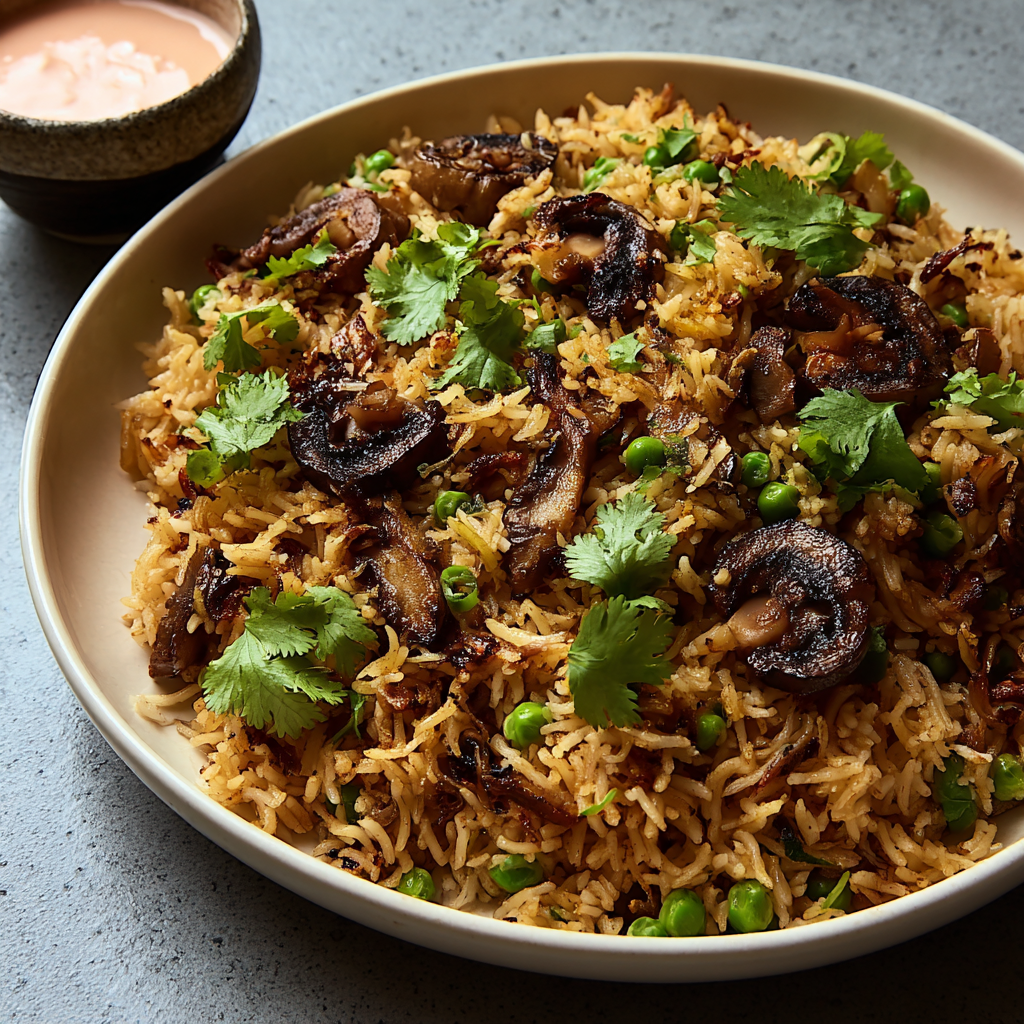Introduction
Stirring a pot of mushroom biryani feels like summoning warmth and comfort into your kitchen — a swirl of fragrant spices dancing with tender mushrooms and fluffy basmati rice, all coming together in a symphony of aroma and flavor. With each scoop, you’re greeted by steam carrying hints of earthy mushrooms, warm cardamom, and toasted cumin. The textures delight too: silky soft rice, meaty mushrooms, and occasional pops of sautéed onions or toasted nuts. It’s the kind of dish that feels like home, yet also speaks of bold spices and festive tables.
This mushroom biryani is ideal when the weather turns a bit cooler, or when you crave something hearty yet elegant. It’s vegetarian comfort food that doesn’t compromise on depth — the mushrooms soak up the spices beautifully, and the rice becomes fragrant and inviting. Serve it on a cozy night in, or make it the centerpiece of a family dinner; it brings together hearts and plates alike.
Why You’ll Love This Recipe
- Rich, layered flavors — from aromatic spices to deep, earthy mushrooms and fragrant rice.
- Comforting and satisfying — hearty and warming, yet balanced and light enough for everyday meals.
- Vegetarian, yet substantial — mushrooms add a meaty texture without heaviness.
- Crowd-friendly & shareable — ideal for family dinners or gatherings; pairs beautifully with sides.
- Make-ahead and adaptable — easy to scale, can be partially prepared in advance, and adapts to dietary needs.
Ingredients
- 2 cups basmati rice, rinsed and soaked 20–30 minutes
- 300–400 g (about 10–14 oz) mushrooms, cleaned and sliced (cremini, button, or mixed wild mushrooms)
- 1 large onion, thinly sliced
- 2–3 cloves garlic, minced
- 1-inch piece ginger, minced or grated
- 2 green chilies, slit lengthwise (optional, adjust to taste)
- 2–3 tablespoons cooking oil (vegetable, sunflower, or light olive oil)
- 2 tablespoons unsalted butter (or ghee for richer flavor)
- 1 teaspoon cumin seeds
- 4–5 green cardamom pods
- 4 cloves
- 1 small cinnamon stick (about 1 inch)
- ¾ teaspoon turmeric powder
- 1 teaspoon coriander powder
- ½ teaspoon red chili powder (adjust to taste)
- 1 teaspoon garam masala
- Salt, to taste
- 3–3¼ cups vegetable broth or water (adjust based on rice type)
- Fresh coriander (cilantro), chopped — for garnish
- Fresh mint leaves, a handful, roughly chopped — for garnish
- Optional garnishes: toasted nuts (slivered almonds or cashews), fried onions, a squeeze of lemon juice
Instructions
- Prep the rice
- Rinse the basmati rice under cold water until the water runs clear to remove excess starch. Soak in cold water for 20–30 minutes. Drain well before cooking.
- This helps the rice expand fully and stay separate, resulting in light, fluffy grains.
- Sauté whole spices
- In a heavy-bottomed pot or deep skillet, heat oil + half the butter over medium heat. Add the cumin seeds, cardamom pods, cloves, and cinnamon stick. Sauté for ~1 minute until fragrant.
- Add the sliced onions and cook until golden brown — stirring occasionally so they caramelize slowly (~8–10 minutes).
- Add aromatics and mushrooms
- Stir in the garlic, ginger, and green chilies. Sauté for 1–2 minutes until aromatic.
- Add the sliced mushrooms, sprinkle a pinch of salt, and sauté until the mushrooms release their liquid and begin to soften (~5–7 minutes).
- Spice it up
- Reduce heat slightly. Stir in turmeric, coriander powder, chili powder, and a bit of salt. Mix well so mushrooms are evenly coated. Cook for another 2 minutes.
- Layer rice and liquid
- Gently spread the drained rice over the mushroom-spice mixture — do not stir.
- Pour vegetable broth (or water) evenly over the rice. Sprinkle garam masala on top. Drizzle the remaining butter (or ghee) over the rice. Add salt to taste.
- Cook gently
- Bring to a gentle boil over medium-high heat. Once liquid begins to bubble, reduce heat to low, cover tightly with a lid. Let simmer undisturbed for 15–18 minutes, or until rice has absorbed the liquid and is tender.
- Turn off heat and let it sit covered for another 5–10 minutes for steam to finish cooking rice — this helps separate grains and deepen flavors.
- Finish and garnish
- Fluff the rice gently with a fork to mix mushrooms and rice without breaking grains.
- Sprinkle fresh coriander and mint over the top. Add optional toasted nuts, fried onions, or a squeeze of lemon for brightness. Serve warm.
You Must Know (Helpful Tips)
- Use quality basmati rice — long-grain rice with good quality yields fragrant, separate grains. Rinsing and soaking are key.
- Don’t skip the whole spices and aromatic steps — they build the flavor foundation; rushing or omitting them will make the biryani flat.
- Spread rice gently over mushrooms — avoid stirring. This layering technique helps ensure the rice cooks evenly without becoming mushy.
- Cover the pot tightly — a snug lid traps steam to cook the rice properly; any leaks can dry out the top layer.
- Let it rest after cooking — the resting time lets steam redistribute, producing fluffier rice and deeper flavor melding.
- Adjust liquid carefully — if your rice is older or shorter-grain, it might need slightly less liquid. Too much makes rice soggy.
Storage Tips
- Refrigerate: Cool to room temperature, then store in an airtight container in the fridge for up to 2 days.
- Reheat: Warm gently on the stovetop over low heat, sprinkling a few tablespoons of water or broth and covering to add moisture. Alternatively, microwave in intervals, stirring gently halfway.
- Freezing (not ideal): Biryani texture changes when frozen; for best results, eat fresh or refrigerate — freezing may dry out mushrooms or make rice mushy.
Ingredient Substitutions
- Rice: If you don’t have basmati, long-grain jasmine or other long-grain rice can work — though flavor and grain separation may differ.
- Mushrooms: Mix in other vegetables — e.g., diced eggplant, cauliflower florets, or peas — for variation. Use firm mushrooms for better texture.
- Spices: Adjust spice mix to your taste — add a pinch of saffron soaked in warm water for a floral aroma, or a bay leaf for depth.
- Broth: Vegetable broth adds more depth; water is fine, but flavor will be milder. A splash of coconut milk (¼ cup) can add creaminess if you like richer biryani.
- Dairy-free / vegan: Use plant-based butter or extra oil. Omit butter/ghee and stick to oil if you follow a vegan diet.
Serving Suggestions
- Serve with plain yogurt or cucumber raita to balance spices and add creamy cooling contrast.
- Accompany with fresh salad (tomato-onion-cucumber with lemon and herbs) for brightness.
- Add pickles or mango chutney for tang and contrast.
- For a fuller meal, pair with grilled vegetables or kebabs (veg or meat) and a side of warm flatbread or naan.
Pro Tips
- For extra fragrance, garnish with a few whole toasted spices (e.g., lightly crushed cardamom pods or a cinnamon stick) on top — adds visual appeal and a subtle aroma as you dig in.
- If you like a more “dum biryani” feel (steam-cooked), after the initial cooking, wrap the lid in a clean kitchen towel before sealing — this traps steam more effectively and results in more aromatic rice.
- For festive presentation, layer the biryani in a wide, shallow dish, garnish with fresh herbs and toasted nuts, and serve family-style right on the dining table — it’s warm, homey, and inviting.
- Leftovers work surprisingly well as a fried rice: sauté gently with a little oil and extra veggies for a new twist.
Frequently Asked Questions (FAQ)
Q: Can I skip soaking the rice?
A: Soaking helps the grains expand and cook evenly — if you skip it, rice may cook unevenly or clump together. If short on time, rinse thoroughly and reduce liquid slightly, but results won’t be as light and fluffy.
Q: My mushrooms release a lot of water — should I drain them?
A: It’s okay — the water helps cook the rice. Just be sure to cook mushrooms until most liquid evaporates before adding rice, so you avoid soggy texture.
Q: I like it spicier — can I add more chili?
A: Absolutely — increase chili powder or add more green chilies to taste. Serve with yogurt or raita to balance heat.
Q: Can I make this biryani in a rice cooker or Instant Pot?
A: Yes, though the flavor layering might shift slightly. If using a rice cooker: after sautéing spices and mushrooms in a pan, transfer everything to the cooker, add soaked rice and liquid, and cook per rice cooker instructions. For Instant Pot: use sauté mode for spices/mushrooms, then add rice and liquid, seal, cook on “rice” setting, followed by natural release.
Q: Is it possible to make this gluten-free?
A: Yes — the recipe is naturally gluten-free, assuming your spices or broth contain no hidden gluten. Always check ingredients if using store-bought broth or spice blends.
Closing Sentence
Comforting, vibrant, and full of fragrant warmth — this mushroom biryani brings together humble ingredients and aromatic spices to create a dish that’s heartwarming, satisfying, and perfect for sharing around the table. I hope it warms your kitchen and fills your home with joy.



